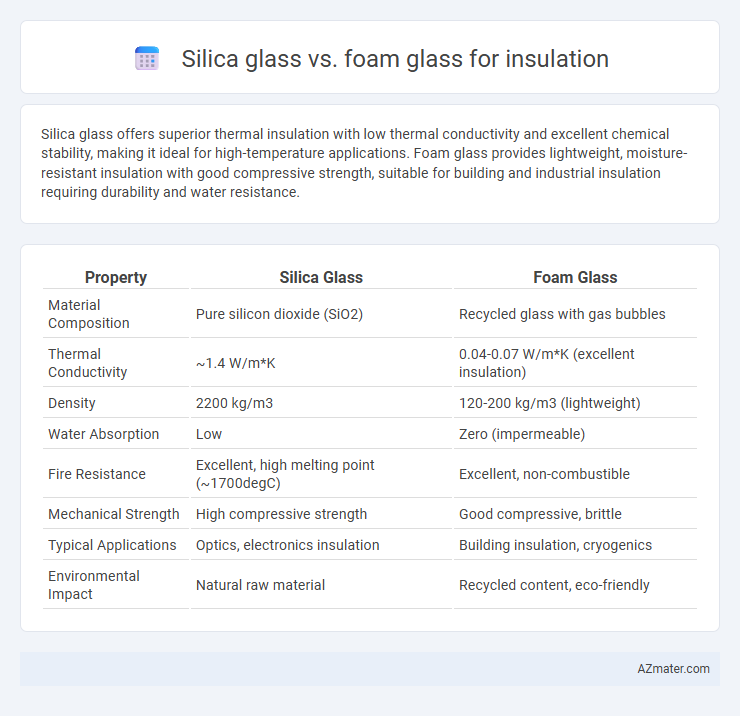Silica glass offers superior thermal insulation with low thermal conductivity and excellent chemical stability, making it ideal for high-temperature applications. Foam glass provides lightweight, moisture-resistant insulation with good compressive strength, suitable for building and industrial insulation requiring durability and water resistance.
Table of Comparison
| Property | Silica Glass | Foam Glass |
|---|---|---|
| Material Composition | Pure silicon dioxide (SiO2) | Recycled glass with gas bubbles |
| Thermal Conductivity | ~1.4 W/m*K | 0.04-0.07 W/m*K (excellent insulation) |
| Density | 2200 kg/m3 | 120-200 kg/m3 (lightweight) |
| Water Absorption | Low | Zero (impermeable) |
| Fire Resistance | Excellent, high melting point (~1700degC) | Excellent, non-combustible |
| Mechanical Strength | High compressive strength | Good compressive, brittle |
| Typical Applications | Optics, electronics insulation | Building insulation, cryogenics |
| Environmental Impact | Natural raw material | Recycled content, eco-friendly |
Introduction to Silica Glass and Foam Glass Insulation
Silica glass is a non-crystalline form of silicon dioxide known for its excellent thermal stability, low thermal conductivity, and high resistance to thermal shock, making it ideal for insulation in high-temperature applications. Foam glass insulation is a lightweight, porous material produced by heating crushed glass with a foaming agent, providing excellent compressive strength, moisture resistance, and thermal insulation properties. Both materials offer unique benefits: silica glass excels in extreme temperature environments, while foam glass is favored for its durability and resistance in moist or mechanical load conditions.
Composition and Manufacturing Processes
Silica glass insulation primarily consists of high-purity silicon dioxide formed through melting and controlled cooling processes, resulting in a dense, non-porous structure with excellent thermal resistance. Foam glass is produced by crushing recycled glass combined with a foaming agent, then heating to create a lightweight, cellular structure with trapped gas bubbles that provide superior insulation and moisture resistance. Manufacturing silica glass involves vitrification at temperatures above 1700degC, while foam glass requires sintering and foaming at around 800-900degC, yielding different microstructures optimized for specific thermal and mechanical properties.
Thermal Insulation Properties: Silica vs Foam Glass
Silica glass exhibits superior thermal insulation properties due to its low thermal conductivity, typically around 0.03 W/m*K, making it ideal for high-temperature applications. Foam glass, while slightly higher in thermal conductivity at approximately 0.04 to 0.06 W/m*K, offers excellent moisture resistance and compressive strength, enhancing insulation durability. Both materials provide effective thermal barriers, but silica glass excels in extreme heat environments whereas foam glass balances insulation with physical robustness.
Mechanical Strength and Durability Comparison
Silica glass offers superior mechanical strength with high compressive resistance and excellent thermal stability, making it ideal for environments requiring robust long-term performance. Foam glass insulation provides enhanced durability through its closed-cell structure, ensuring exceptional resistance to moisture, chemical corrosion, and dimensional stability under fluctuating temperatures. When comparing both, silica glass excels in mechanical strength, while foam glass is favored for its durability and resilience in harsh conditions.
Moisture Resistance and Water Absorption
Silica glass offers exceptional moisture resistance with a very low water absorption rate, making it ideal for environments exposed to high humidity or direct moisture. Foam glass provides outstanding waterproof insulation due to its closed-cell structure, which prevents water penetration and absorption, ensuring long-term durability in wet conditions. Both materials excel in moisture resistance, but foam glass typically outperforms silica glass in preventing water absorption in highly saturated or submerged applications.
Fire Resistance and Safety Features
Silica glass offers superior fire resistance due to its high melting point of around 1,650degC, making it an excellent barrier against extreme heat and flames. Foam glass insulation provides inherent fire safety by being non-combustible and resistant to moisture, preventing mold growth and structural degradation. Both materials enhance fire safety, but silica glass excels in high-temperature resistance while foam glass is advantageous for combined fire protection and thermal insulation.
Environmental Impact and Sustainability
Silica glass, derived from natural quartz sand, offers excellent thermal insulation with minimal environmental impact due to its abundant raw materials and recyclability. Foam glass insulation, made from recycled glass combined with foaming agents, provides superior sustainability by utilizing waste materials and exhibiting a low carbon footprint in production. Both materials contribute to energy efficiency, but foam glass stands out for its enhanced circular economy benefits and resistance to moisture and chemicals.
Cost Analysis: Silica Glass vs Foam Glass
Silica glass insulation generally offers higher thermal performance but comes with a significantly higher initial cost compared to foam glass, which is more budget-friendly and provides adequate insulation for many applications. Foam glass features a lower density and ease of installation, reducing labor expenses, whereas silica glass may require specialized handling that increases overall project costs. Long-term savings can favor silica glass in energy efficiency, but foam glass remains a cost-effective option for projects with strict budget constraints.
Typical Applications in Building and Industry
Silica glass is commonly used in high-temperature insulation applications such as furnace linings, laboratory equipment, and thermal barriers due to its excellent thermal stability and low thermal expansion. Foam glass serves as an effective insulation material in building foundations, roofing systems, and industrial pipelines owing to its lightweight, moisture resistance, and compressive strength. Both materials are chosen based on the specific thermal, mechanical, and environmental requirements of construction and industrial projects.
Choosing the Right Insulation: Key Factors to Consider
Silica glass offers superior thermal stability and low thermal conductivity, making it ideal for high-temperature insulation applications, while foam glass provides excellent compressive strength and moisture resistance for structural insulation needs. Choosing the right insulation depends on factors like operating temperature range, mechanical load requirements, and environmental exposure, with silica glass preferred for extreme heat and foam glass suited for damp or load-bearing conditions. Cost-efficiency and installation complexity also influence the optimal choice between silica glass and foam glass insulation materials.

Infographic: Silica glass vs Foam glass for Insulation
 azmater.com
azmater.com